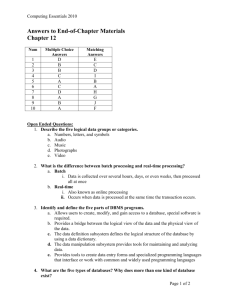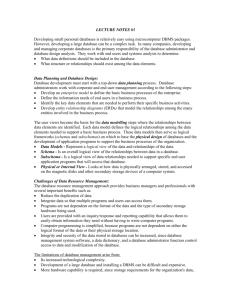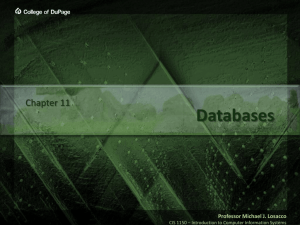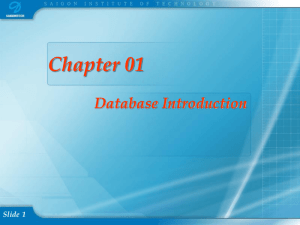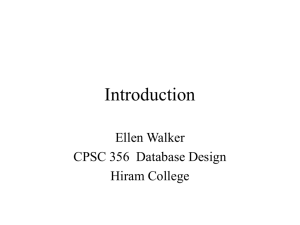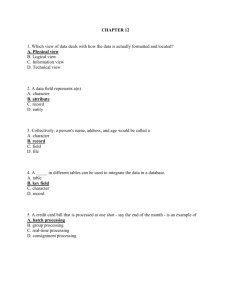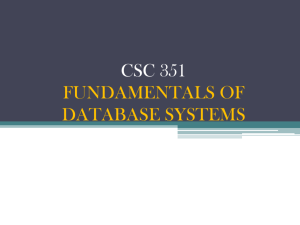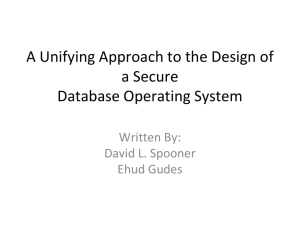Chapter 11 PowerPoint Answers
advertisement
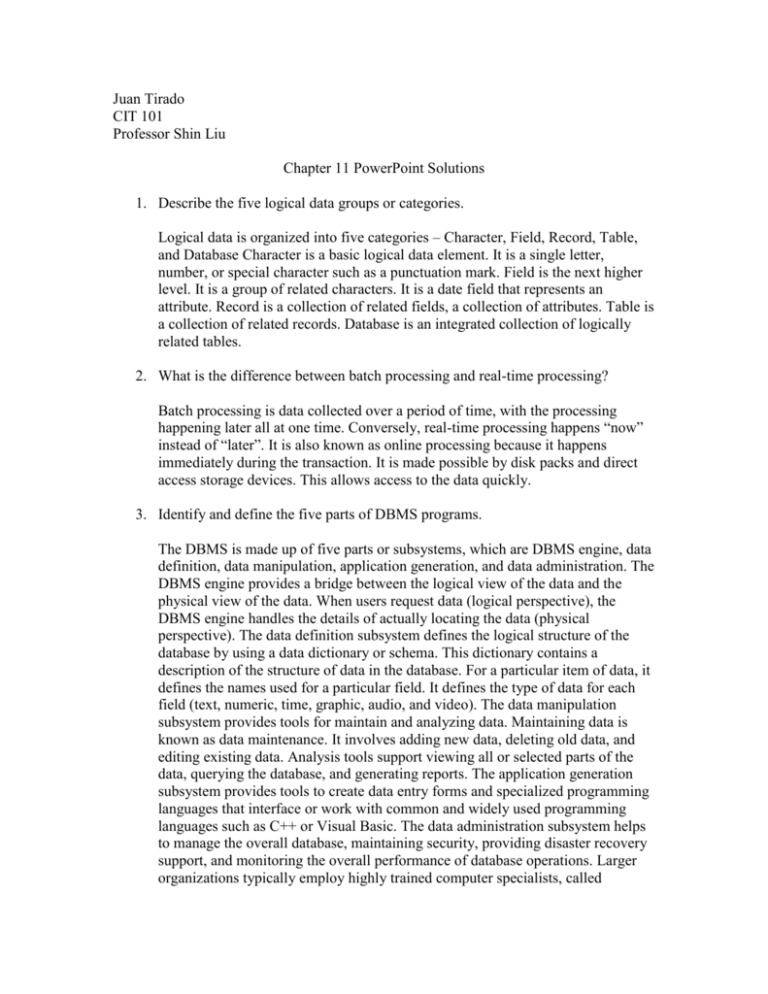
Juan Tirado CIT 101 Professor Shin Liu Chapter 11 PowerPoint Solutions 1. Describe the five logical data groups or categories. Logical data is organized into five categories – Character, Field, Record, Table, and Database Character is a basic logical data element. It is a single letter, number, or special character such as a punctuation mark. Field is the next higher level. It is a group of related characters. It is a date field that represents an attribute. Record is a collection of related fields, a collection of attributes. Table is a collection of related records. Database is an integrated collection of logically related tables. 2. What is the difference between batch processing and real-time processing? Batch processing is data collected over a period of time, with the processing happening later all at one time. Conversely, real-time processing happens “now” instead of “later”. It is also known as online processing because it happens immediately during the transaction. It is made possible by disk packs and direct access storage devices. This allows access to the data quickly. 3. Identify and define the five parts of DBMS programs. The DBMS is made up of five parts or subsystems, which are DBMS engine, data definition, data manipulation, application generation, and data administration. The DBMS engine provides a bridge between the logical view of the data and the physical view of the data. When users request data (logical perspective), the DBMS engine handles the details of actually locating the data (physical perspective). The data definition subsystem defines the logical structure of the database by using a data dictionary or schema. This dictionary contains a description of the structure of data in the database. For a particular item of data, it defines the names used for a particular field. It defines the type of data for each field (text, numeric, time, graphic, audio, and video). The data manipulation subsystem provides tools for maintain and analyzing data. Maintaining data is known as data maintenance. It involves adding new data, deleting old data, and editing existing data. Analysis tools support viewing all or selected parts of the data, querying the database, and generating reports. The application generation subsystem provides tools to create data entry forms and specialized programming languages that interface or work with common and widely used programming languages such as C++ or Visual Basic. The data administration subsystem helps to manage the overall database, maintaining security, providing disaster recovery support, and monitoring the overall performance of database operations. Larger organizations typically employ highly trained computer specialists, called database administrators, to interact with the data administration subsystem. Additional duties of database administrators include determining processing rights or determining which people have access to what kinds of data in the database. 4. Describe each of the five common database models. The five common data models are Hierarchical, Network, Relational, Multidimensional, and Object-oriented. In hierarchical, data is structured in nodes organized like an upside-down tree. Each parent node can have several children while each child node can have only one parent. Network is like hierarchical except that each child can have several parents. Relational is data stored in tables consisting of rows and columns. Multidimensional is data stored in data cubes with three or more dimensions. Object-oriented organizes data using classes, objects, attributes, and methods. 5. What are some of the benefits and limitations of databases? Why is security a concern? There are many benefits to databases as there are many kinds with specific functions to help both general business purposes. There are business directories that provide addresses, financial and marketing information, products, and trade brand names. There is demographic data, such as county and city statistics, current estimates on population and income, employment statistics, census data, etc. There is business statistical information, such as financial information on publicly traded companies, market potential of certain retail stores, and other business data and information. Text databases provide articles from business publications, press releases, reviews on companies and products. Web databases cover a wide range of topics, including all of the above. Some of the limits with maintaining databases however, means that users must make constant efforts to keep them from being tampered with or misused. Security is a big issue. One concern is that personal and private information about people stored in databases may be used for the wrong purposes. For example, a person’s credit history or medical records might be used to make hiring or promotion decisions. Another concern is unauthorized users gaining access to a database. For example, there have been many instances when a computer virus has been launched into a database or network.
